|
Sadaf asks:
Hi, I am planning to seat for YKI test. It's been a year since I am planning this. But I have a small baby and it's really hard to study or prepare for the exam. Can I have any suggestion on how to pass YKI test level 3. I have finished Suomen mestari 1. Dear Sadaf, Thank you for the great question! Studying with a small baby is definitely a huge challenge. When I think back to the first year of my own child’s life, my first thought is that it was often a huge challenge to just somehow keep everyone fed, warm and relatively clean, and to keep our home from descending into complete chaos. I don’t think it would have been possible for me personally to study for a standardized test at that time. However, that’s not to say that you shouldn’t attempt it! Babies, families and experiences are really different, and what would have been an impossible task for me may be a really fun and rewarding journey for you. Everything I say in this post is comes with a caveat: depending on you situation, this may be really bad advice. But I hope that some of it can be helpful! 1. Is there a Finnish course for parents of small children available near you? Depending on where you're located, there might be a Finnish course or language café available that is specifically designed for your situation, with child care options and extra support. Your local neuvola (Finnish maternity and child care clinic, literally "the advice place") should be able to point you in the right direction. 2. Think about how you could build some Finnish into your everyday life. When is the best time of the day for you to learn? Learning doesn't have to mean quiet, uninterrupted time. It can be something connected to your everyday routines: for example, you could talk to your baby in Finnish for 5 minutes every morning or have a podcast for Finnish learners on in the background of other things. Little daily routines like this go a very long way. 3. Connect with others I know for a fact that you’re not the only one struggling with this, and many struggles become smaller when you have community. So, my advice would be to find others who are in the same situation as you are and to support each other in your efforts. I know it’s easier said than done, especially in the blur that life with a baby tends to be, but it’s well worth the effort if it’s possible for you. One option is a non-profit organization called Mothers In Business. It’s one great way to connect with others in the same situation for peer support. There are Facebook groups, online and face to face mingles and all kinds of grear events. Here's the international wing. Mothers in Business International has also organized language cafés and conversation groups for Finnish learners in the past (I’m proud to say that I was part of the very first chapter in 2020), and I think there might be more coming in the future. There are many other great non-profits and organizations that can help you connect with other parents of small children. One really prominent one that is active all over Finland is Mannerheimin lastensuojeluliitto, MLL for short. Again, your local neuvola is a great place to find out what is available in your area. 4. Give yourself enough time You still have some way to go before YKI level, and you're in a challenging stage in your life. You're most likely at level A1 now, which means you need to climb two more levels on the CEFR scale until you reach B1 and YKI level. From basic level, you need to get to independent level, which means that you can manage in most everyday situations if Finnish. Your goal is absolutely, 100 % reachable, but be patient with yourself and your process. 4. What textbooks to use If you're able to keep studying with a text book or even attend a course, it would be good to study at least Suomen mestari 2 in addition to Suomen mestari 1, preferably also Suomen mestari 3. Or, if Suomen mestari isn’t doing it for you, you might want to opt for another texbook like Sun suomi (from 0 to A2, explanations in English), Oma suomi 1 and 2 or No niin 1 and 2. It might be worth getting these out of the library to try them out and see what resonates. Here’s some more general YKI preparation advice, including lots of links to materials and so forth. I hope this helps, good luck! You can do this! P.S: I’m teaching a self-paced course on the speaking portion of the YKI test. Pre-recorded video lessons and exercises for you to go through at your own pace and lots of teacher support by email and on Facebook. The current chapter of the course in ongoing right now. It's still possible to join in, but it's still too soon for your current language level. However, there will be further chapters coming up if you're interested. The next one will be in January 2024. Here are all my upcoming Finnish courses. Nate asks:Terve! I’d like to ask what your suggestions are for someone (me) who is trying to become proficient in speaking Finnish again after not speaking it for many years. I find that I can still form sentences and have rudimentary conversations in Finnish with myself in my head, but, those don’t last very long due to losing my vocabulary. I’d just like to be able to speak with my Finnish friends again, and feel confident speaking face to face when I come to visit. Kiitos paljon! My aNSWER:Terve Nate! This is such an important topic, thank you for asking this question! An important part of getting really good at a language is accepting the fact that your progress won’t be linear. There will be months and sometimes years that will go by where you aren’t doing anything you’re your Finnish skills, which means that you will forget some of the things that you have learned, and everything will kind of rust over. Starting to speak Finnish after a long break can feel like banging your head against a wall. Why can’t I remember any vocabulary? Shouldn’t I know this by now? Here are some things that have worked for my students and also for me personally when I’ve needed to recover or reactivate other languages. (Hi Spanish, Hungarian, and Swedish! Hola, hej, szia!) 1. Let go of should. You know what you know now and that’s enough. Yes, you used to know more, were able to speak more fluently and were able to express yourself in many situations. That doesn’t matter, your current skills are what they are and they’re enough as they are, for now. Sometimes, language learners are so busy beating themselves up about what they feel they should know that they don’t have any energy at all left for learning. Don’t let that happen to you! So, accept where you are now and then start thinking about where you want to get to. 2. Think of other things that you’re good at. What skills are applicable in this situation? For example, if you’re someone who likes to paint, you probably have the experience of not having done it for a while, picking it back up and having to face the fact that you’re not the painter you used to be. This goes for anything that requires skill, whether it’s reading, writing, posting on social media, yoga, tennis, running, knitting, cooking… How did you overcome the challenge of picking something back up again in other parts of your life? What has worked for you previously? Can you do the same with Finnish? 3. Start by reviving some of your passive language skills. Listen to something or read something that you enjoy. Listening to music is one great option, as that’s something that can be enjoyable even if you don’t understand a single word. 3. Get into a routine of actively doing something in Finnish regularly. It sounds like you’re already doing some of this, which is great! Talk to yourself in Finnish for 5 minutes every morning, write a few words in a journal, comment on social media posts in Finnish. Do whatever feels like the easiest and most fun way of getting rid of the rust you’ve accumulated. 4. Think about using a textbook to help you revise what you already know. If you go this route, it might be worth getting a new textbook for a fresh take on familiar things. A good option for someone who wants to revise the very basics while also broadening and deepending their skills is Sun suomi, which has explanations in English. Another good textbook for revision is Oma suomi 1 (level 0 to A2) and 2 (level A2 to B1). If you can handle a heavy layout and aren’t too thrown off by typos, a textbook called Finnish tutor is also a great resource for revision. One caveat: the language in a lot of Finnish textbooks for beginners gets quite difficult quite quickly, so don’t be angry at yourself if your level A2 (lower intermediate) textbook feels really demanding when you used to be at B2 (advanced). Of course, if you already have a textbook that you know and like, there’s nothing wrong with revising with that one! The books that I’ve mentioned here are the ones that I think might be the best in this situation, but they definitely aren’t the only options available, far from it. 5. Find a course to attend. Finnishcourses.fi is good place to start looking, and Kielibuusti is another. If you’re not in Finland, there are many great online courses available. Taking a few private lessons is another great way to get rid of that rust and to regain confidence in your skills in an efficient way. 6. Find ways to start using the language again in real life. Think of the situations that you’d like to speak Finnish in and then get into those situations. If you're not in Finland, think about what you can do online. Remember to let go of the should and trust the process. The skills you had aren’t lost forever, they’re just rusty. It will take some time to get to the place where you once were, but it will happen quite quickly if you let it. Onnea matkaan, sä pystyt siihen! Good luck, you can do it! Readers, what are your tips for speaking Finnish again after a long break? Comment below or on Facebook, Instagram, LinkedIn or Twitter. José asks:
A good question is how to say TURN ON and TURN OFF. 1. Turn ON the light - Turn OFF the light. 2. Turn ON the cellphone - Turn OFF the cellphone. 3. Turn ON the computer - Turn OFF the computer. 4. Turn ON the television - Turn OFF the television. 5. Turn ON the iron (clothes iron) - Turn OFF the iron Hi José! Thank you for a great question! This blog post is completely based on my own intuition of how to best translate your sentences. In other words, I haven’t done any research for this like I normally do for these blog posts. I have a strong feeling that researching all of these would lead us down a deep rabbit hole, so I’ve decided to just rely on my own native speaker feel for the Finnish language. This of course means that there’s a bigger risk than usual that other speakers might prefer another version. Here we go, let’s look at these one at a time! 1. Turn ON the light - Turn OFF the light. Sytyttää valo – Sammuttaa valo or Laittaa valo päälle – Laittaa valo pois päältä. 2. Turn ON the cellphone - Turn OFF the cellphone. Laittaa puhelin päälle – Laittaa puhelin pois päältä. With this one, you can use sammuttaa for turn off, so just like turning off the light: Sammuttaa puhelin. But sytyttää doesn’t work here, because sytyttää puhelin would mean that you’re lighting your phone on fire, which you obviously want to avoid. Another verb that you can use for turning on is käynnistää, but it sounds a bit overly formal for everyday use: Käynnistää puhelin. – To turn on the cellphone. 3. Turn ON the computer - Turn OFF the computer. Laittaa tietokone päälle. – Laittaa tietokone pois päältä. Käynnistää tietokone. – Sammuttaa tietokone. Again, don’t light your computer on fire, avoid the verb sytyttää! Another option is sulkea ‘to close’ for turning off: Sulkea tietokone. For turning on, avata ‘to open’ is also sometimes used, especially if you’re on a laptop: Avasin tietokoneen aamulla. – I turned my computer on or opened my computer. 4. Turn ON the television - Turn OFF the television. Laittaa televisio päälle. – Laittaa televisio pois päältä. Avata televisio. – Sulkea televisio. For some reason, käynnistää sounds formal to the point of absurdity with televisio, in a way that it doesn’t for computers or phones. 5. Turn ON the iron (clothes iron) - Turn OFF the iron Laittaa silitysrauta päälle – Laittaa silitysrauta pois päältä. Here, the other options for turn on and turn off don’t sound correct, but I'm not sure why that is. If we look at all of the examples above, we can see that laittaa päälle ‘turn on’ and laittaa pois ‘turn off’ work really nicely for all your examples, and I’d say for all electrical appliances in general. At least I can’t immediately think of one where I wouldn’t say laittaa päälle/pois. Then we have some other options like avata, sulkea, käynnistää, sammuttaa, sytyttää that work in some contexts but not in others. It would be fascinating to look at all of these in more detail to find out why that’s the case, but we’ll leave that for another day! Readers, can you think of other ways to translate these sentences? Colleagues and other skilled Finnish speakers reading these: do you agree with my translations? Is there something here that you would express differently? Let me know in the comments! In my previous post all the way in December, I wrote about how to get started on your path to mastering the Finnish language.
When you’re starting out, it’s a good idea to really to think about your goals, how much time and energy you’re going to dedicate to your studies and most important of all, how to make learning as fun and rewarding as possible. In this post, I go through some of the different paths that you can take when you start your journey and share some resources that will hopefully be useful to you as you start your journey. Also, you don’t need to limit yourself to one thing. In fact, it’s often useful to do a combination of things that work for your schedule, your resources and your individual preferences. 1. A face to face group course. A good face to face group course has many advantages: you get to know other people working towards the same goal, you have a teacher to guide you and at best, your lessons will be lots of fun. Leaving your home to go to class can be both a great advantage and a disadvantage: it can take a lot of time and energy to physically get to class, but on the other hand a lot of people really benefit from physically being present at a lesson as opposed to online learning. A group course that works for you might even give you energy instead of just demanding it! Finding a face to face group course of course depends on where you’re located. If you’re in Finland and in a city, a good place to start looking is finnishcourses.fi. I personally only have experience with schools in the Helsinki metropolitan area, and even then of course only from the point of view of a teacher. Some great places to study in Helsinki are Eiran aikuislukio, Helsingin aikuisopisto and Helsingin työväenopisto, but there are many others as well! 2. An online group course. A good online group course will have many of the advantages of a face to face class, but can be a lot more convenient to fit into your schedule. Typically, online group courses will have regular meetings on a platform like Zoom or Teams with at least a portion of the lesson in brekout rooms. There’s usually also a learning environment for homework like Moodle, Google Classroom or Peda.net. Finnishcourses.fi is also a great place to start your search for these. Many small providers also organize their own beginners’ courses. One great option is my friend and colleague Taru Eloranta, whose courses you can find here. 3. A self-paced online course can be a great option if your schedule is very busy and it’s hard to find a regular time for a group course. I don’t have a specific course that I’m able to personally recommend at the moment, but I know these exist and would love to design one myself one day. Let me know in the comments if you know of a good one! 4. Private lessons are a wonderful way to study without having to worry about the pace of the course being too slow or too fast. The downside of private lessons is that you don’t have a group to support you, but they come with the advantage of the teacher being focused only on you. Private lessons are also a much bigger financial investment than group courses: lessons by qualified Finnish teachers based in Finland range from about 60 to 110 euros per 45 minutes at the time I'm writing this. However, there are students who teach private lessons for much less, and many of my colleagues living outside of Finland are able to charge much less. Here’s a good list of private Finnish teachers compiled by Hanna Männikkölahti from Random Finnish Lesson (who is also a wonderful teacher and colleague). 5. Self-paced learning with a textbook. This is a demanding path to take, as studying on your own demands lots of discipline and you risk feeling lost. However, I’ve seen a lot of students take this path and get great results, so I don't want to discourage it either! The best textbook that I know of for this path is the Suomen mestari series, but Oma suomi, Sun suomi (English explanations) are also good options. 6. Other great resources when you’re starting out. There are many wonderful apps and websites that can help you on your path. Duolingo of course is very popular. Some of my own favorites are
I would love to hear from you in the comments! If you're just starting out, what are you wondering about the most? If you've already further along on your path, what was useful for you in the beginning? A question I get asked often is some version of this: I’d like to learn Finnish, but have no idea where to start. What would you recommend? There are many good ways to learn languages, and you’re the best judge of what would work for you best. Here are some things to think about as you start your journey: 1. Your goal(s). I think the main consideration before you start is your goal: where do you want to be with your Finnish language skills in a year? Two years? Five? When I ask this question, most people will reply that they want to be fluent in Finnish and be able to function in Finnish in every area of their lives. But really take some time to think about your goal: is there some more specific situation that you need Finnish for? Do you have Finnish relatives that you’d like to communicate with? Or would you like to be able to follow the news on Yle, or handle your everyday life in Finnish? Your goal plays a big role in determining what steps make the most sense. 2. Time and energy. How many hours of studying and practicing are you willing to put in? In general, the more time and energy you’re able to dedicate to your studies, the better and faster the results will be. However, learning languages always takes time, and there’s a limit to how much we can absorb each day, so it’s important to find a balance that works for you. Taking enough time to rest and process things is also a big part of learning Finnish. 3. What is fun for you? Learning is much more efficient when it’s enjoyable. Students often have a very fixed idea of what learning a language should look like, and a common misconception is that the only way to learn a language is to spend time studying grammar and vocabulary. There’s nothing wrong with doing that, and for me personally, it’s something that I love doing. But really think about what you enjoy, and think about how your could incorporate that in your studies. Maybe it’s attending a traditional Finnish course, but it could also be attending a dance class in Finnish, watching tv or listening to music in Finnish, or hanging out in Finnish speaking environments even if you have no idea what anyone is saying at first. It could be a gamified language learning app or other language learning games, reading, writing poems… Basically, anything you can think of. When you’ve thought about these things, you can start looking at the next steps to take. Read about those in part 2 of this post. Picture by StartupStockPhotos
Vural asks:
How can i learn verbi rektio helposti (easily). What is logic for them? My answer: Hi Vural, thanks for the great question! Rektio or rection means the phenomenon in Finnish where a verb (or another word) needs words that go together with the verb to be in a certain form. For example, the verb tykätä ‘to like’ goes together with the elative or Mistä case. Mä tykkään suklaasta. I like chocholate+Mistä. I like chocolate. The elative also means ‘where from’: Mistä sinä tulet? Where are you coming from? That means that rections can be really confusing and difficult to remember in the beginning. The trick is to learn the verb and its rection as a whole. I like to think of minä tykkään + Mistä as a frame where I can susbtitute X with anything: Minä tykkään X:stä - I like X Minä tykkään suklaasta - I like chocolate Minä tykkään sinusta - I like you Minä tykkään pullasta - I like pulla and so forth. My main advice for learning verb rections is learning them verb by verb along with the form that goes with the verb. So each time your learn a new verb, look at how is behaves in a sentence, and pay attention to the forms of the other words in the sentence. However, there are patterns and even a certain logic to verb rections. Verbs and their rections fall into patterns, and it can really help to know about these patterns. Here are a few common ones to start with. For example, verbs that express a sensory experience go together with the ablative case (miltä): Ruoka tuoksuu ihanalta. - The food smells wonderful. Paita näyttää hyvältä. - The shirt looks good. Musiikki kuulostaa hyvältä. - The music sounds good. Hieronta tuntuu mukavalta. - The massage feels nice. With these verbs, the allative case (mille) is also possible and means exactly the same thing. Uusi kielemme has done a wonderful job listing different rection patterns, so I won’t do the same job twice! You can find all their rection articles here: https://uusikielemme.fi/?s=rections Rections are an example of Finnish grammar where it’s easy to get overwhelmed and lose steam. How can I say anything at all if I’m not sure about what case the other words should be in? The good news is, it’s often not a big deal to choose the wrong form. Rections are also something that native speakers struggle with, because they are sometimes different in spoken forms Finnish and standard written Finnish. The Finnish case system is just like the prepostition system of English and other European languages, where there’s a lot to learn case by case and mistakes are to be expected during the learning process. Just like in English, there might be some minor misuderstandings if you choose the wrong form, but usually not serious ones. As you hear and read more and more Finnish, the correct forms will start to become automatic. Readers, what has worked for you for learning rections? Question: My Finnish teacher and my friends keep telling me that I should stop translating everything from English to Finnish and start thinking in Finnish instead. I have no clue how to do that. How do I start thinking in another language? My answer: This is an area of language learning that I find fascinating, thank you for the great question! In this post, I’ll share what works for me as a language learner, and what many of my students have also found helpful. Thinking practice. Set a timer for 5 minutes and do your best to think in Finnish for that period of time. You will, inevitably, think in other languages as well, but any time you notice it bring yourself back to the effort of thinking in Finnish. At first, it may be that you aren't able to think in Finnish at all, but when you keep going, you'll start to notice it getting easier and easier. However, a caveat with this one: not everyone has an inner monologue where they “speak” a specific language in their head, in which case I recommend the next technique. Talking to yourself. Another really helpful technique is to talk to yourself out loud in Finnish for a set period of time. Even one minute a day, five days a week, does wonders. If you want to speak with any fluency, you can’t do a lot of translating, so talking out loud almost forces you to start thinking in Finnish. Talking to others. No matter how difficult this may seem at first, start speaking Finnish in real life situations, even if it's just a few words a day. Remember that there's no shame in having to switch to another language when you need to, but try to stick to Finnish as best you can. Reading in Finnish. Regular reading in Finnish has the benefit of almost automatically switching your thoughts to Finnish. I recommend you start with a selkokirja, a novel in easy Finnish. My personal favorite is Yösyöttö by Eve Hietamies (original novel) and Hanna Männikkölahti (easy Finnish adaptation). Another great option is following the news in easy Finnish. All of these techniques work best if you can build them into your daily routine. I’m trying to get better at speaking French, so I spend the walking or biking distance between my child’s daycare and my office either thinking in French or speaking it out loud. I avoid weird looks by having my headphones on, so it looks like I’m talking on the phone or taking a Zoom call (or, if I’m feeling confident, I’ll ditch the headphones and embrace the weird looks). I also know many French people living in Helsinki who are kind enough to want to speak French with me, so I also do my best to speak French every week. Readers, what’s your experience? How did you make the switch from translating to thinking in Finnish? Were you able to start thinking in Finnish right at the start of your learning journey, or was it a process that took some time? What worked for you? Picture by Finmiki
Today, I’ll be answering two questions on the same topic. Here both questions first:
Enitan writes: Hei Mari, how are you today? Could you help with a link that gives a distinct explanation on akkusatiivi and genetiivi? I've searched through your blog but couldn't find anything related to it. Thanks Sigrid writes: Moi! Onko akkusatiivi vielä suomenkielessä? Mulla on ikivanha suomen-norja oppikirja, ja siellä on akkuusatiivi, mutta uusissa kirjoissa se on pikemminkin genitiivi, vaikka se on erilainen (genetiivi yksikössä ja nominatiivi monikossa, ja persoonapronominit ovat myös erilaisia). Toivottavasti ymmärrät mitä tarkoitan! My translation: Hi! Is the accusative still in the Finnish language? I have a very old Finnish-Norwegian textbook, and they talk about the accusative, but new textbooks will rather talk about the genitive, though it’s differen (genitive in the singular and nominative in the plural, and personal pronouns are also different) I hope you understand what I mean! My answer: Hi Enitan and Sigrid, thanks for the great questions! There's a bit of a terminology issue here, as akkusatiivi or accusative can mean different things. As Sigrid noticed, older and newer books use different words to talk about the object. In most modern grammars, akkusatiivi means the object forms of the personal pronouns: Näin sinut eilen. I saw you yesterday. sinut = akkusatiivi of the word sinä The corresponding question word is also in the accusative form: Kenet näit eilen? Who(m) did you see yesterday? kenet = akkusatiivi of the word kuka In every other type of word, the same form is the genitive case: Näin Marin eilen. I saw Mari yesterday. Mari is in the genitive case, which tells us that Mari is the object of the sentence, the person being seen. However, in older grammars, they usually refer to the form Marin as akkusatiivi as well, which is pretty confusing. And also nominative objects might be called accusatives. In modern grammars, there are two types of objects: 1. Partitive objects (partitiiviobjekti). These are always in the partitive case. Juon kahvia. I’m drinking coffee or some coffee. Minun täytyy juoda kahvia. I have to drink coffee or some coffee. 2. Total objects (totaaliobjekti). These can be in the genitive, nominative or accusative case. 2.1 Genitive (genetiivi): Juon kahvin. I’m drinking a coffee (I have a defined amount and I’m drinking all of it). 2.2 Nominative (nominatiivi eli perusmuoto) Minun täytyy juoda kahvi. I have to drink a coffee. 2.3 Accusative Näin heidät eilen. I saw them yesterday. If you speak a language that has something called the aspect, like Slavic langugages or Hungarian, you might find that this sounds familiar. Slavic languages and Hungarian have different verb forms to describe ongoing processes and actions that are over and done with. Finnish expresses the same thing by changing the form of the object. So to recap, the case of the total object is either the genitive or the nominative, or for personal pronouns and their corresponding question words, the accusative (minut, sinut, kenet). In older grammars, these were called accusative objects instead of total objects, and kahvin was said to be in the accusative case. This was confusing because the same word was used for both the case and the phenomenon, and also the accusative case looks exactly like the genitive in modern Finnish, so some linguists decided to make the terminology clearer by starting to talk about total objects instead of accusative objects. However, changing the terminology resulted in even more confusion, because now we have two sets of competing terms flying around. If you’re already familiar with the concept of accusatives, it might be useful to use the old terminology, but if you’re not, I’d say stick with the new terminology. In my classes, I often find myself talking about genetiivi-akkusatiivi to help everyone follow along (though I’m not sure how helpful that monster of a word really is). If you’d like to read about all this in more detail, the wonderful website Uusi kielemme has a very comprehensive article about the object in English. A reader writes: I'm a complete beginner, and my only motivation to study Finnish is to pass the YKI test. I would like some guidance on how to achieve my goal as efficiently as possible, and I don't think regular language course are the way to go. Do you have a specialized YKI curriculum for beginners? My answer: Thank you for the great question, which is something that I get asked quite often, so you’re not alone in wondering this! Unfortunately, I have some bad news for you: there isn't any shortcut to the language skills needed to pass the YKI test. Passing the intermediate YKI is a great and valuable goal, but it’s quite an impossible one to reach without acquiring basic language skills first. If your one and only goal is to pass the intermediate YKI test (the level required for citizenship), you will likely require more time to get to the required level, not less. The YKI test is a highly practical kind of language test. It tests your ability to manage in Finnish in a variety of everyday situations, and the best possible preparation for YKI is using as much Finnish as possible in your everyday life. The required level to pass the YKI test is also quite high (YKI 3 or B1). It's a level that enables you to go about your daily life in Finnish, to read and listen to the news and even to handle more complicated things like banking and taxes in Finnish. If you have Finnish relatives, at B1 you can understand the coffee table conversations their kahvipöytäkeskustelu and participate. You can read novels in easy Finnish without too much of a struggle, you can study at vocational school (if you have support with the language), you can watch the news and television and listen to music and understand what's going on. If your goal is Finnish citizenship, wouldn't you also love to be able to do all these things? Only about third of the Finnish population is fluent in English so you're missing out on a lot if you are only communicating in English. My number one advice for you would be a regular beginner's course in Finnish or private Finnish lessons. A good place to start looking is Finnishcourses.fi, which hosts quite a comprehensive listing of Finnish courses in the Helsinki region and in other big cities as well as online. If you’d prefer to work with a private teacher, check out Hanna’s listing of private Finnish teachers, as well as this simple padlet page which lists courses by small teaching businesses like mine. Once you're at an early intermediate level (late stages of A2 in CEFR speak), I'd love to have you in my YKI preparatory courses, which is to what you're looking for but for intermediate learners: a specifically designed curriculum for students who are aiming for the intermediate YKI test in Finnish. Here’s a blog post to help you figure out if you’re ready. Luckily, as the YKI is such an everyday kind of language test, attending a well designed YKI course will have the added benefit of helping you better your real life language skills as well. Some students of mine also attend my YKI courses just for the general language skills without aiming for YKI, and many also continue the course series after passing the YKI test. I wish you the best of luck on your learning journey with this wonderful language! I'd love to hear from those of you who have already attended a beginner's course. What worked? What didn't? Leave a comment or join the conversation on my Facebook page, LinkedIn or Twitter. Picture by Pexels
Question: All my usual Finnish courses are on a break in July, but I’d like to keep up with my Finnish. Any ideas on how to do that? What a great and timely question! Most schools and training providers are closed in July (including my own small teaching business), but otherwise the summer is a great time to study and practice Finnish. Here are some ideas on how to do that. 1. Speak Finnish in real life situations. I know that this can feel like jumping into the deep end if you’re still at the beginning of your journey (and even later on), but there’s no shame in just using the Finnish you have and then switching to English or another language when you need to. Even if you just know a few words in Finnish, there’s already a lot you can do with just ”Hei, kahvi, kiitos” (look at you ordering a coffee in Finnish just like a native speaker would). If you’re in Finland, there are countless opportunities to speak Finnish in everyday situations: cafés, shops, libraries, the market, museums… The list is endless! You can also find some great opportunities to practice online, like social media (especially groups and pages centered around your interests are great, though a bit more advanced of course). For example, you could join a online bookclub, chat about parenting or join a foraging group. 2. Talk to yourself in Finnish. Out loud or by trying to think in Finnish, at home, in the car, while exercising. Just switching your brain to Finnish (or trying to) once in a while is really beneficial for your overall language skills. Don't worry about making mistakes, the key thing is to practice speaking or thinking in Finnish. 3. Self-study courses. There are some great self-study courses and learning materials that you can use any time, many of them free of chage. For beginners, Superalkeet is great, and Työelämän suomea is excellent if you’re at a more intermediate level. Puhutsä suomee is a good introduction to spoken Finnish and suitable for many levels, depending on how familiar you are with puhekieli. The freely available material Kotisuomessa goes from 0 all the way to B2. Apps like Duolingo, WordDive and Glossika can also be great. This is another list that just goes on and on! 4. Series, books, podcasts, music. These are always a good idea, even alongside a course. Books in easy Finnish are a great idea at level A2 and up, watching tv in Finnish with or without subtitles is great at every level. Listening to podcasts and music in Finnish will help you level up your language skills even if you don’t understand a single word at first. 5. Clubs and language cafés. Many Finnish language clubs and language cafés still continue meeting up in the summer, both online and offline. For example, here are all the events organized by the public libraries in Helsinki, all over the capital city region and online as well. Once you’re at an intermediate level, the topic of the meetup doesn’t have to be about learning Finnish at all – think of what you’re interested in and find out how to do that with others in Finnish. It could be an open university course on a topic you love or a dance class. 7. Attend a course or hire a private teacher. Luckily, not everyone is on a summer break in July. For example, my lovely colleagues Päivi Virkkunen and Liis Viks are available for private lessons all through the summer. Ihanaa kesää!
ihana-partitiivi kesä-partitiivi summer-partitive lovely-partitive = Have a lovely summer! |
Archives
September 2023
|
Ask a Finnish Teacher / Toiminimi Mari NikonenBUSINESS ID (Y-Tunnus) 2930787-4 VAT NUMBER FI29307874 Kaupintie 11 B 00440 Helsinki If you'd like to send me something in the mail, please email me for my postal address. mari@askafinnishteacher.com +358 40 554 29 55 Tietosuojaseloste - Privacy policy |
© COPYRIGHT 2015-2022 Mari nikonen. ALL RIGHTS RESERVED.
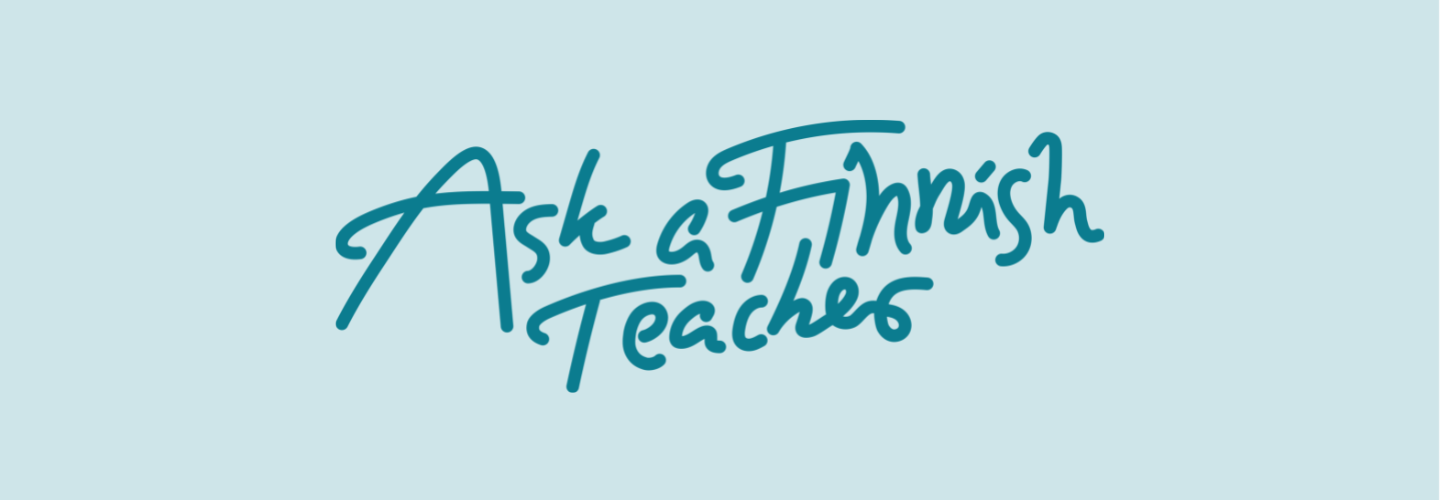
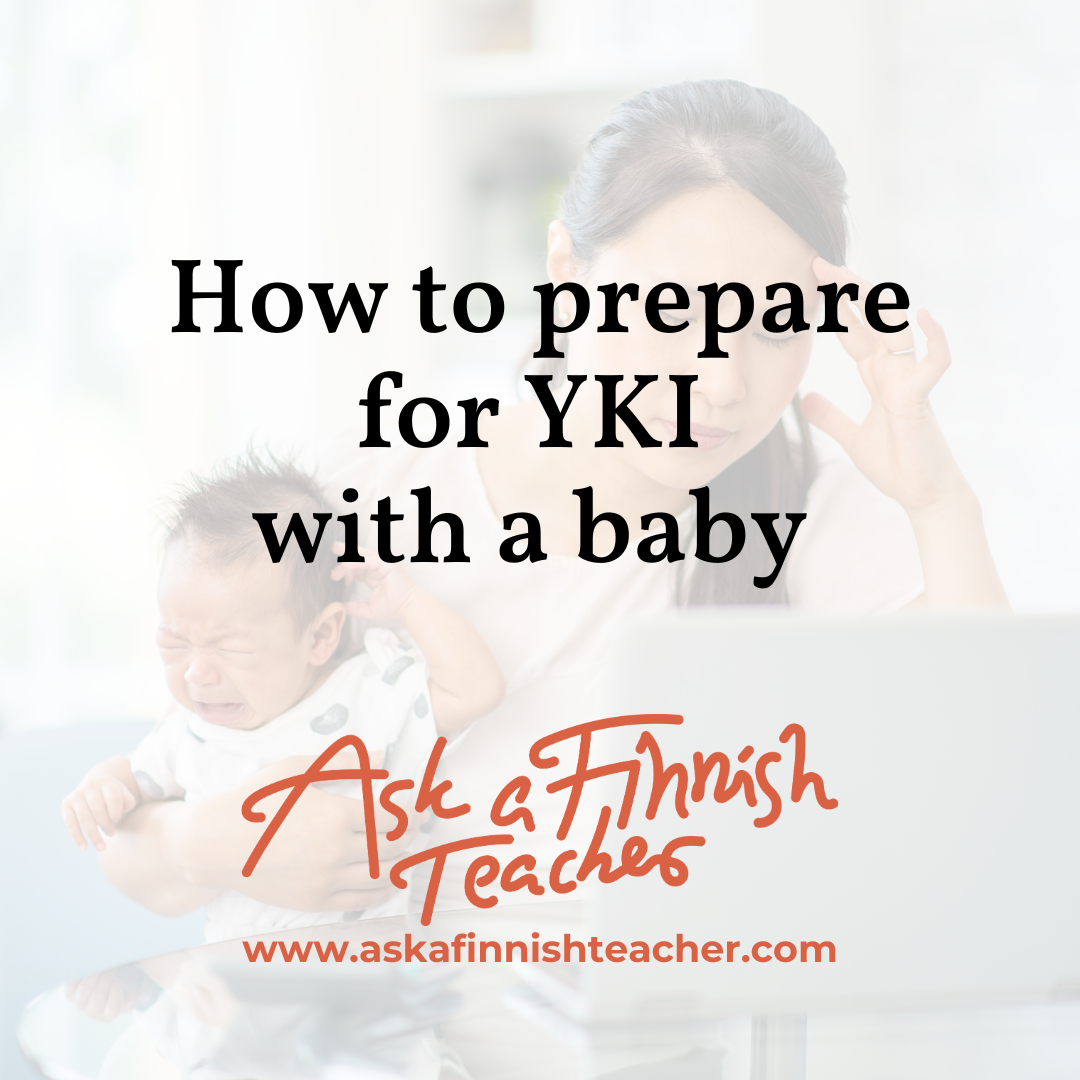
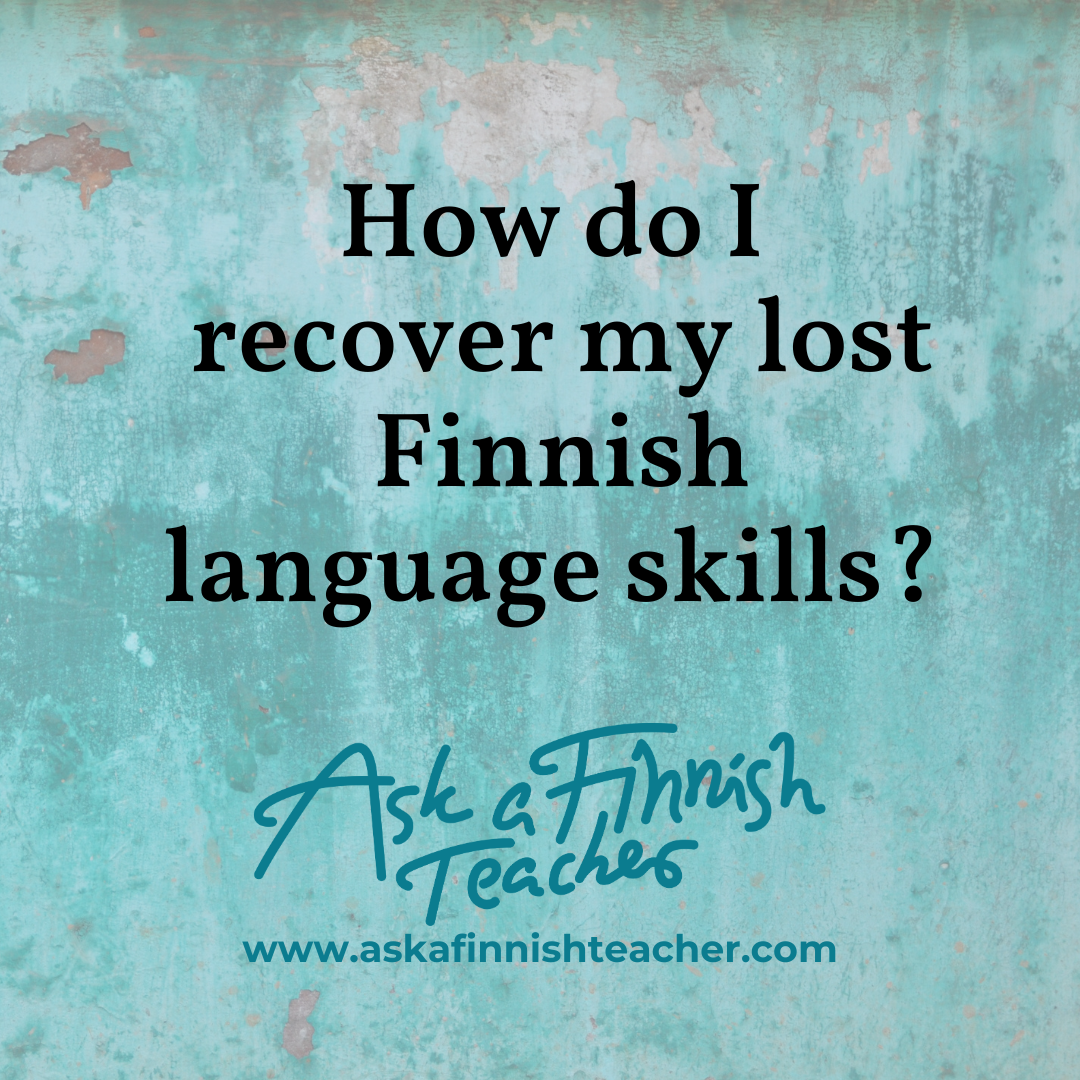
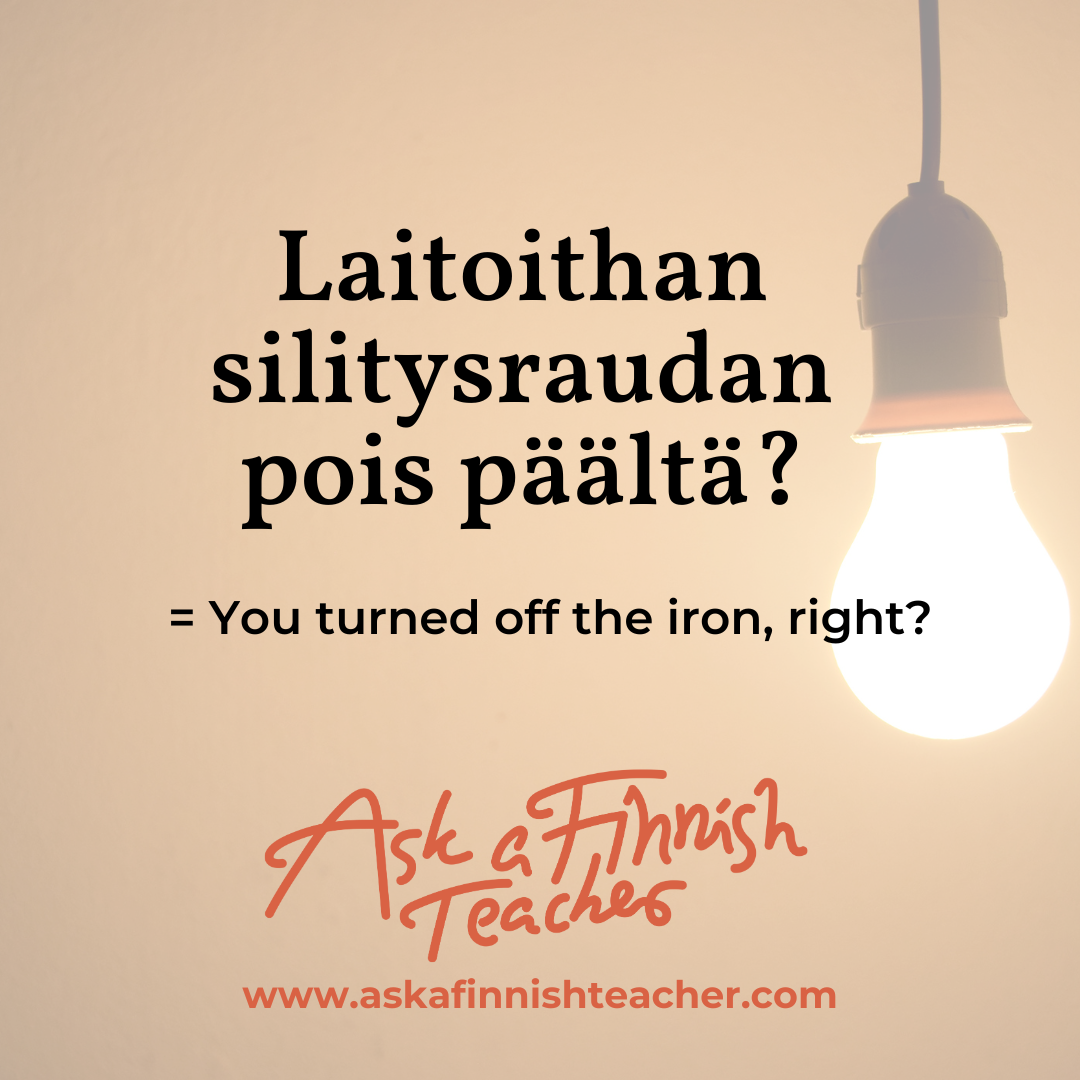






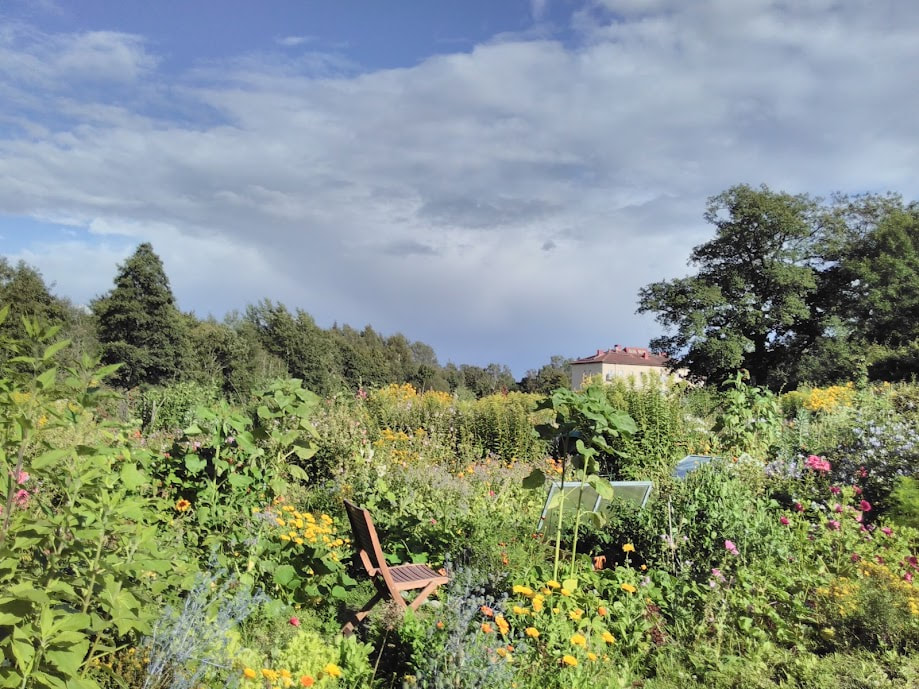
 RSS Feed
RSS Feed